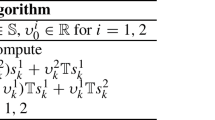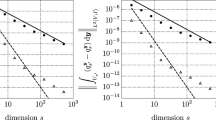Abstract
We investigate \(C^1\) finite element methods for one dimensional elliptic distributed optimal control problems with pointwise constraints on the derivative of the state formulated as fourth order variational inequalities for the state variable. For the problem with Dirichlet boundary conditions, we use an existing \(H^{\frac{5}{2}-\epsilon }\) regularity result for the optimal state to derive \(O(h^{\frac{1}{2}-\epsilon })\) convergence for the approximation of the optimal state in the \(H^2\) norm. For the problem with mixed Dirichlet and Neumann boundary conditions, we show that the optimal state belongs to \(H^3\) under appropriate assumptions on the data and obtain O(h) convergence for the approximation of the optimal state in the \(H^2\) norm.
Similar content being viewed by others
References
Adams RA, Fournier JJF (2003) Sobolev spaces, 2nd edn. Academic Press, Amsterdam
Bergh J, Löfström J (1976) Interpolation spaces. Springer, Berlin
Brenner SC, Scott LR (2008) The mathematical theory of finite element methods, 3rd edn. Springer, New York
Brenner SC, Sung L-Y (2017) A new convergence analysis of finite element methods for elliptic distributed optimal control problems with pointwise state constraints. SIAM J Control Optim 55:2289–2304
Brenner SC, Sung L-Y, Zhang Y (2013) A quadratic \(C^0\) interior penalty method for an elliptic optimal control problem with state constraints. In: Karakashian O, Feng X, Xing Y (eds) Recent developments in discontinuous Galerkin finite element methods for partial differential equations, volume 157 of The IMA Volumes in Mathematics and its Applications. Springer, Cham-Heidelberg-New York-Dordrecht-London, pp 97–132. (2012 John H. Barrett Memorial Lectures)
Brenner SC, Davis CB, Sung L-Y (2014) A partition of unity method for a class of fourth order elliptic variational inequalities. Comput Methods Appl Mech Eng 276:612–626
Brenner SC, Oh M, Pollock S, Porwal K, Schedensack M, Sharma N (2016) A \(C^0\) interior penalty method for elliptic distributed optimal control problems in three dimensions with pointwise state constraints. In: Brenner SC (ed) Topics in numerical partial differential equations and scientific computing, vol 160. The IMA Volumes in Mathematics and its Applications. Springer, Cham-Heidelberg-New York-Dordrecht-London, pp 1–22
Brenner SC, Gedicke J, Sung L-Y (2018) \(C^0\) interior penalty methods for an elliptic distributed optimal control problem on nonconvex polygonal domains with pointwise state constraints. SIAM J Numer Anal 56:1758–1785
Brenner SC, Gudi T, Porwal K, Sung L-Y (2018) A Morley finite element method for an elliptic distributed optimal control problem with pointwise state and control constraints. ESAIM:COCV 24:1181–1206
Brenner SC, Sung L-Y, Zhang Y (2019) \(C^0\) interior penalty methods for an elliptic state-constrained optimal control problem with Neumann boundary condition. J Comput Appl Math 350:212–232
Casas E, Bonnans JF (1988) Contrôle de systèmes elliptiques semilinéares comportant des contraintes sur l’état. In: Brezzis H, Lions JL (eds) Nonlinear partial differential equations and their applications, 8th edn. Longman, New York, pp 69–86
Casas E, Fernández LA (1993) Optimal control of semilinear elliptic equations with pointwise constraints on the gradient of the state. Appl Math Optim 27:35–56
Ciarlet PG (1978) The finite element method for elliptic problems. North-Holland, Amsterdam
Deckelnick K, Günther A, Hinze M (2009) Finite element approximation of elliptic control problems with constraints on the gradient. Numer Math 111:335–350
Ekeland I, Témam R (1999) Convex analysis and variational problems. Classics in Applied Mathematics. Society for Industrial and Applied Mathematics (SIAM), Philadelphia
Ito K, Kunisch K (2008) Lagrange multiplier approach to variational problems and applications. Society for Industrial and Applied Mathematics, Philadelphia
Lions JL, Magenes E (1972) Non-homogeneous boundary value problems and applications I. Springer, New York
Liu W, Gong W, Yan N (2009) A new finite element approximation of a state-constrained optimal control problem. J Comput Math 27:97–114
Luenberger DG (1969) Optimization by vector space methods. Wiley, New York
Murthy MKV, Stampacchia G (1973) A variational inequality with mixed boundary conditions. Israel J Math 13(188–224):1972
Nečas J (2012) Direct methods in the theory of elliptic equations. Springer, Heidelberg
Ortner C, Wollner W (2011) A priori error estimates for optimal control problems with pointwise constraints on the gradient of the state. Numer Math 118:587–600
Rudin W (1966) Real and complex analysis. McGraw-Hill Book Co., New York
Schwartz L (1966) Théorie des distributions. Hermann, Paris
Wollner W (2012) Optimal control of elliptic equations with pointwise constraints on the gradient of the state in nonsmooth polygonal domains. SIAM J Control Optim 50:2117–2129
Author information
Authors and Affiliations
Corresponding author
Additional information
Publisher's Note
Springer Nature remains neutral with regard to jurisdictional claims in published maps and institutional affiliations.
The work of the first and second authors was supported in part by the National Science Foundation under Grant Nos. DMS-16-20273 and DMS-19-13035.
Appendices
Appendix A. KKT conditions for the Dirichlet boundary conditions
First we note that
since \(\int _I y'dx=0\) and \(\int _I\psi \,dx>0\), and also
Let \({\mathscr {K}}=\{v\in H^1(I)/{\mathbb {R}}:\,v\le \psi \;\) in \(I\}\). We can rewrite (2.4) in the form of
where
and the function \(\Phi \in H^1(I)/{\mathbb {R}}\) is defined by
Let the bounded linear functional \(L:H^1(I)/{\mathbb {R}}\longrightarrow {\mathbb {R}}\) be defined by
Observe that (A.3) implies
since in this case \(\pm \epsilon v+p\in {\mathscr {K}}\) for \(0<\epsilon \ll 1\).
Since the active set \({\mathscr {A}}\) is a closed subset of [0, 1], according to (A.1) there exist two numbers \(a,b\in I\) such that \(a<b\) and \([a,b]\cap {\mathscr {A}}=\emptyset\). Let \(G=(-1,a)\cup (b,1)\). Then we have (i) \({\mathscr {A}}\,\cap I\subset G\) and (ii) there exists a bounded linear extension operator \(E_{\scriptscriptstyle G}:H^1(G)\longrightarrow H^1(I)/{\mathbb {R}}\).
Remark A.1
Observe that a bounded linear extension operator \(E_G^*:H^1(G)\longrightarrow H^1(I)\) can be constructed by reflections (cf. Adams and Fournier 2003). The operator \(E_G\) can then be defined by
where \(\phi\) is a smooth function with compact support in (a, b) such that \(\int _I \phi \,dx=1\).
We define a bounded linear map \(T_{\scriptscriptstyle G}:H^1(G)\longrightarrow {\mathbb {R}}\) by
where \({\tilde{v}}\) is any function in \(H^1(I)/{\mathbb {R}}\) such that \({\tilde{v}}=v\) on G. \(T_{\scriptscriptstyle G}\) is well-defined because the existence of \({\tilde{v}}\) is guaranteed by the extension operator \(E_{\scriptscriptstyle G}\) and the independence of the choice of \({\tilde{v}}\) follows from (A.7).
Let \(v\in H^1(G)\) be nonnegative. Then \(-\epsilon {\tilde{v}}+p\in {\mathscr {K}}\,\) for \(0<\epsilon \ll 1\) because \(p\le \psi\) on G and \(p<\psi\) on the compact set \([a,b]=I\backslash G\). Hence we have
It follows from (A.9) and the Riesz-Schwartz Theorem (cf. Rudin 1966; Schwartz 1966) for nonnegative functionals that
where \(\mu _{\scriptscriptstyle \bar{G}}\) is a nonnegative Borel measure on \([-1,a]\cup [b,1]\).
Because of (A.8) and (A.10), we have
and the observation (A.7) implies that \(\mu _{\scriptscriptstyle \bar{G}}\) is supported on \({\mathscr {A}}\).
We conclude from (A.6) and (A.11) that
where \({\tilde{\mu }}\) is the trivial extension of \(\mu _{\scriptscriptstyle \bar{G}}\) to \([-1,1]\). It follows that
where \(\mu =\beta {\tilde{\mu }}\), and in view of (A.2), (A.4), (A.5) and (A.12),
Appendix B. KKT conditions for the mixed boundary conditions
In this case we have, by (2.1b),
Let \({\mathscr {K}}=\{v\in H^1(I;1):\,v\le \psi \quad \text {in I}\}\). We can rewrite (2.4) in the form of
where
and the function \(\Phi \in H^1(I;1)\) is defined by
Note that \(f\in H^1(I)\) by the assumption in (1.7). After integration by parts, the inequality (B.2) becomes
The variational inequality defined by (B.3) and (B.5) is equivalent to a second order obstacle problem with mixed boundary conditions whose coincidence set is identical to the active set \({\mathscr {A}}\) in (2.10).
Since \(\psi \in H^2(I)\) by the assumption in (1.7), we can apply the penalty method in Murthy and Stampacchia (1973) to show that
and, after integration by parts, we have
where
and \(\delta _{-1}\) is the Dirac point measure at \(-1\).
The variational inequality (B.5) is then equivalent to
Consequently the KKT conditions (2.7)–(2.9) hold for the Borel measure
Remark B.1
In the special case where \(f=0\) and \(\psi\) is a positive constant, the condition (B.9d) implies \(p'(-1)=0\) if \(-1\not \in {\mathscr {A}}\), and the conditions (B.9a) and (B.9c) imply \(p'(-1)=0\) if \(-1\in {\mathscr {A}}\). Therefore we have \(p'(-1)=0\) if \(f=0\) and \(\psi\) is a positive constant, in which case \(\mu\) is absolutely continuous with respect to the Lebesgue measure. Hence it is necessary to choose \(\gamma =p'(-1)=0\) in Example 2.10.
Rights and permissions
About this article
Cite this article
Brenner, S.C., Sung, LY. & Wollner, W. Finite element methods for one dimensional elliptic distributed optimal control problems with pointwise constraints on the derivative of the state. Optim Eng 22, 1989–2008 (2021). https://doi.org/10.1007/s11081-020-09491-1
Received:
Revised:
Accepted:
Published:
Issue Date:
DOI: https://doi.org/10.1007/s11081-020-09491-1




